As part of their term two assessment for module EAFM003, the MA Creativity students were asked to create a pop-up event in just twelve weeks. With £250 at the disposal of each group the students went about producing an event to remember. Team Happinesst were one of the lucky few able to open their event before Covid19 prevented the execution of events going forward. The Exeter Happinesst was an interactive pop-up experience celebrating happiness. As one of the team members of The Exeter Happinesst this is my journaling of the process leading up to the event and the event itself.
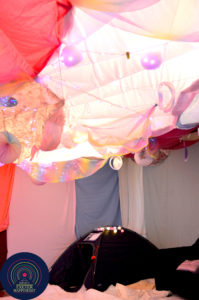
Construction Day One: After weeks of ideation and meticulous planning we began constructing and transforming the events space. I arrived around midday with one other team member to collect some props and equipment we had hired from the Drama Department Technical Team. We had ordered a sizeable events tent to use as a central piece to build what we called ‘the nest’ from. ‘The nest’ would be a fort type space made from fabrics, pegs, and washing lines. It was inspired by the kind of thing you made as a kid to play in. However, the scale and instagramable nature of it would make it more of a spectacle for all ages. ‘The nest’ would be a hub for relaxation, meditation, and good feeling, where you could choose to mingle with others in a safe environment or reflect in your own way. Unfortunately, our events tent from which to construct the nest had arrived missing parts. We also found issues with creating the planned window display. The stressful nature of physically creating an event space over designing it was beginning to set in.
18.00: The rest of the team joined once finished with their busy working days to help begin the construction of the space. Our plan was to work in MakeTank well into the night and return early the next day to continue. I had luckily found a remedy for our window display and after a team meeting, we agreed to abandon the use of the events tent. Instead we began attaching taut washing lines from pillar to pillar in the centre of the event space. From these lines, criss-crossed above our heads like a spider’s web, we would hang fabrics and sheets and attach them using pegs. Most of the evening was spent in high spirits watching ‘the nest’ fabricate. Some positive energy, hard-work ethic, and inspiring music allowed us to press on.
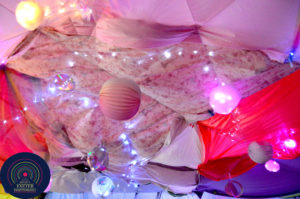
Construction Day Two: The team returned to the space after a good night’s rest with energy and anticipation: today we would finish construction. ‘The nest’ was finished first. Next, projectors and coloured spotlights were set up alongside light stands dressed in white fabrics. This area of the event would be for light displays and projecting natural scenes to induce happy feelings. The back area of MakeTank was obscured using hanging sheets. The space was metamorphosed. I began to wonder what MakeTank had looked like before we had started. The event had taken on its own life with a new aesthetic and authenticity. I felt proud as passers-by would stop and look at our construction through the window. A few I invited to join us in the space at its unveiling to the general public the next day.
As the day progressed so did our event. A second delivery of equipment meant that we could continue to improve. An arts canvas element was added, lights and decorations were hung from the ceiling of ‘the nest,’ and an appreciation of the audience journey began to become imperative. I used some spare props to create another component for the event: a photograph opportunity or photo corner. This was put together using some abandoned wooden pallets, a few benches, sheets, fairy lights, excess spotlights, soft boxes, and netting. Although it was an unplanned add on element it helped to fill the space and encourage guests to interact through another dimension. My plan was to add the finished images to the Happinesst Facebook page with the guests consent so that audience members could engage with the Happinesst long after their visit had ended.
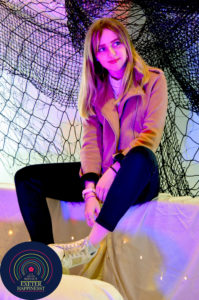
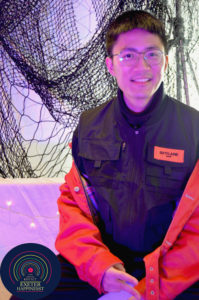
The Event Day- March 14th: The team arrived early to make any last-minute amendments. Hot beverages and snacks were bought to offer to guests, letters were written with kind and heart-felt messages inside which could be taken home on exiting, labels scrawled with positive messages were artfully displayed on a hanging net at the front of the event. The intention behind this was that as guests came and went the net would be filled with multi-coloured labels. This would be a spectacle but also an indicator of our audience engagement with the space. Our module convenors arrived before the guests at 12 o’clock. The team were exhausted but proud of their work. I was dis-heartened by the prospect of having to dismantle everything, but the nature of a pop-up event is just that; to pop-up and disappear leaving only photographs and smiles.
The events unveiling kicked off positively. Guests were invited in off the street by a host and herded around each area of the event by a team member. The event received overwhelmingly positive engagement from young children who enjoyed the visual spectacle of the space. Older participants were amused by the event also. Yet, they engaged more with the social opportunities it had to offer. Guests interacted well with ‘the nest’ and the photograph opportunity. Some guests in their teens and twenties preferred the silent disco headsets and art canvas segment. Celebrating happiness, merriment, and a sense of community is welcome to all audiences and as a result everyone felt favourably about The Exeter Happinesst.
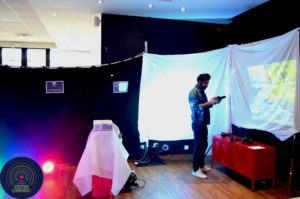
Although the event lasted a short three hours guests who entered left feeling that little bit more important and cherished. For the team and I, it was gratifying to see our creation produce the desired effect. Our vision became a lived-in reality all thanks to the resources and funding our MA course provided. The experience was as close as I have ever felt to being an arts curator or creative director, and even if I go down a different path within the creative sector I will always have this memory to strengthen my flourishing potential as a creative.
